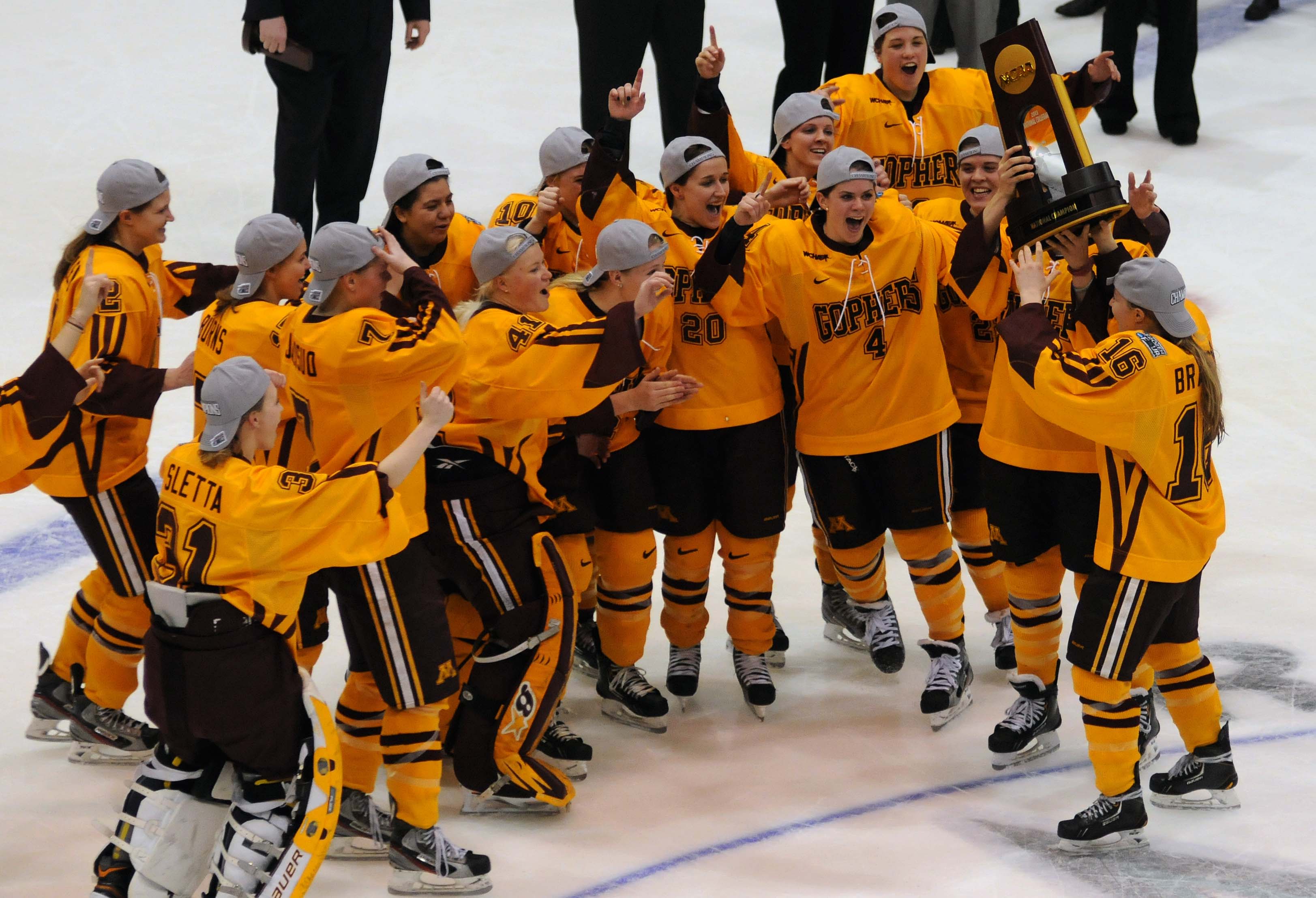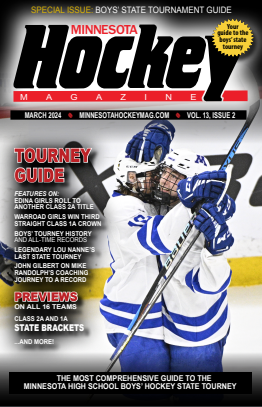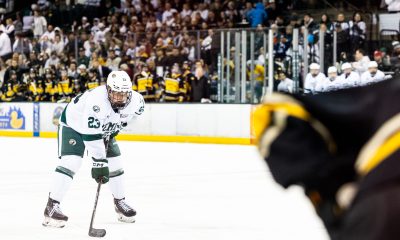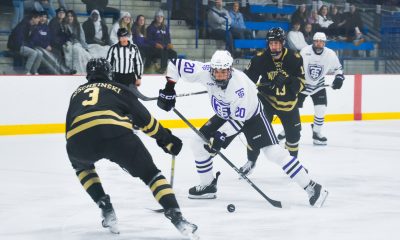College
Women’s Hockey Rivalry: Gophers vs. Bulldogs
Creative stats add spice to Gopher-UMD women’s rivalry.
-

by
John Gilbert

Just about every team in NCAA Division I women’s hockey might have reason to believe they are involved in the most intense rivalry in women’s hockey. But the intensity is closer to a fever pitch whenever the University of Minnesota faces Minnesota Duluth. The series renews this weekend in AMSOIL Arena in Duluth when the Golden Gophers drive up Interstate 35 for games Friday night and Saturday afternoon, and the series might have a little extra edge this time around.
Last season, the Gophers defeated UMD all five times they played, four in the regular season and once in the playoffs. Doubtful that even that landslide completely made up for the sting Minnesota felt when its previous season ended on home ice in a 2-1 loss to the Bulldogs in the 2022 NCAA West Region final.
That’s the sort of thing that is hanging in the balance whenever these two teams meet.
“It’s always a good game,” said UMD defenseman Nina Jobst-Smith. “A lot of players on both teams played against or with each other growing up. That helps raise the level of intensity to some extra animosity. That always makes it more fun. They’re quick, and very offensive from their forwards back to their defense, and they’ve got good goaltending.”
But none of the players, or coaches, involved with the two programs can recall the intensity that was born when the UMD program was born 25 years ago. Minnesota had already been playing for a couple of years, with only Division III Augsburg as an area competitor. When UMD started its hockey program, it was also the first year that enough other Western teams started that the Western Collegiate Hockey Association also started. Both the WCHA and the Bulldogs are celebrating their 25th anniversary this season.
The first time coach Shannon Miller took her Bulldogs team to face the Gophers, UMD won the Dec. 3, 1999 game 5-4. That led to a very interesting bit of intrigue between the two. Minnesota coach Laura Halldorson used her influence to get the first-year WCHA champion invited to participate in a coaches association four-team, postseason invitational tournament in spring of 2000 at Northeastern.
Several times during that season, I asked Halldorson: Since UMD was surprisingly strong, wouldn’t it be great for the WCHA if the top two teams could go to that tournament to make it two East against two West teams? Halldorson was less than tactful when she said, “No. There will be only one West team and it will be us.”
As fate would have it, UMD went on what still stands as a school record 22-game unbeaten streak that first season, and knocked off the Gophers to win the WCHA title, earning the slot in the invitational tournament. That caused Halldorson to pull in all her chips and get the Gophers invited, too, so it ended up being two East and two West teams.
I told Miller that it would be good for the WCHA to have two representatives, but Miller disagreed.
“She insisted all year that there would be only one West team in that tournament, so now she should have to live by what she said,” Miller said at the time.
After I wrote Miller’s comments, Halldorson decided not to speak to me during or after that tournament.
Tournament organizers put UMD and Minnesota against each other in the semifinals of the tournament. Minnesota won that game on the way to winning the invitational tournament championship.
One year later, in the 2000-01 season, the NCAA decided to start holding an NCAA championship for Division I women’s hockey teams, structuring a full regional playoff to determine the four entries. UMD, in its second season, won that first national championship with a powerful team led by goaltender Tuula Puputti, plus Jenny Schmidgall and Maria Rooth — the two top goal scorers in UMD history — plus Hanna Sikio, Erika Holst, and defensemen Navada Russell, Brittny Ralph, and Pamela Pachal.
UMD also won the second and third NCAA tournament championships. The Bulldogs were national champions in the first three national tournaments ever held, starting in their second year of operation.
Of course, that didn’t sit well with anyone connected with the Gophers, who worked feverishly to find a way to get an NCAA title of their own. They finally managed, and reached an elite level of play they have never wavered from. But while they were getting there, Miller led the Bulldogs to two more NCAA championships.
So, in what amounted to the dark of night, the Gophers unceremoniously started referring to that first and only invitational tournament title as a “national championship,” which closed the gap on their reviled “Duluth Branch.”
In later years, Gopher teams caught up and slipped ahead of UMD. Thanks to a team with U.S. Hockey Hall of Famers Krissy Wendell and Natalie Darwitz, the Gophers even went undefeated through a whole season, culminating with an NCAA title. But while nobody else seemed to notice, except me, there is one banner hanging in Ridder Arena amid the six legitimate NCAA National Championship banners, which proclaims 2000 as a “national championship” year.
That would give Minnesota seven national championships, to UMD’s five. But it also means that if you count up all the NCAA national tournaments, there would be one more “championship” than there have been NCAA national tournaments. Current Gopher women’s coach Brad Frost defends the sleight-of-hand, insisting in retrospect that the 2000 invitational tournament at Northeastern was, indeed, a national tournament.
Not true, Brad.
“I never knew that background,” said current UMD coach Maura Crowell. “They can’t just do that, can they?”
That’s just another reason why this weekend’s series between the U of M Gophers and the UMD Bulldogs has that little extra edge, which players on either team might be unable to explain.
In the WCHA, both Minnesota and UMD are rebuilding a bit, while Wisconsin and Ohio State have run off side-by-side to stand tied for first place. This weekend, while Minnesota (5-2) is at UMD (6-2), Wisconsin (8-0) is facing Ohio State (8-0) for the early lead.
In the ranking, Wisconsin is No. 1 in the women’s poll after being unrated to start the season.
Men’s hockey upate
The St. Cloud State men’s team, which struggled a little against a deceivingly tough early schedule, got everything back in order just at the right time to start the NCHC regular season, and reeled off sweeps of 3-2, 6-0 against Miami and 3-2, 3-0 against Western Michigan. SCSU coach Brett Larson said he thought those two teams would be tough later in the season and has warned his troops to not be complacent this weekend when Minnesota Duluth — his alma mater — comes to town for a series.
“We get Duluth when they’re sure to be in a bad mood, having lost twice to North Dakota,” said Larson, who coached at UMD in two terms, helping them win three NCAA men’s titles. “I think the league is going to be tough as ever, and it will be no surprise if any of the eight teams beats any of the others. There are no upsets in the NCHC. You’ve got to be ready every game.”
St. Thomas just made its presence felt in the CCHA, hitting the road to Bowling Green and sweeping. First, the Tommies won 4-1 behind two goals from Liam Malmquist in the first period. Then they followed that up with a 4-3 with two goals in the third period after Cooper Gay scored twice early for the Tommies.


















